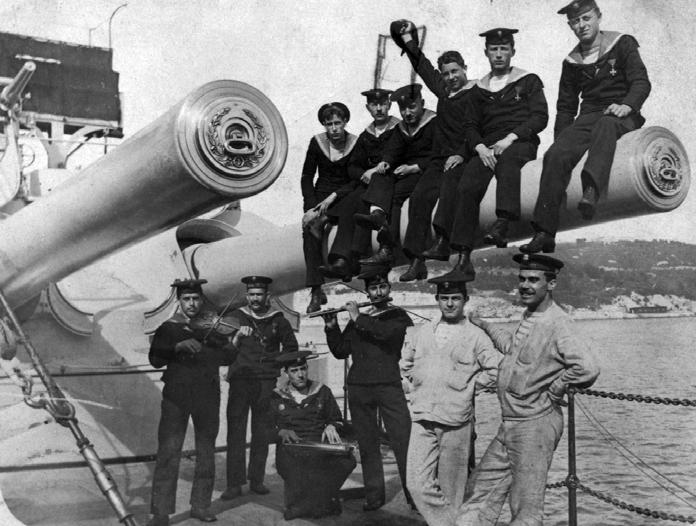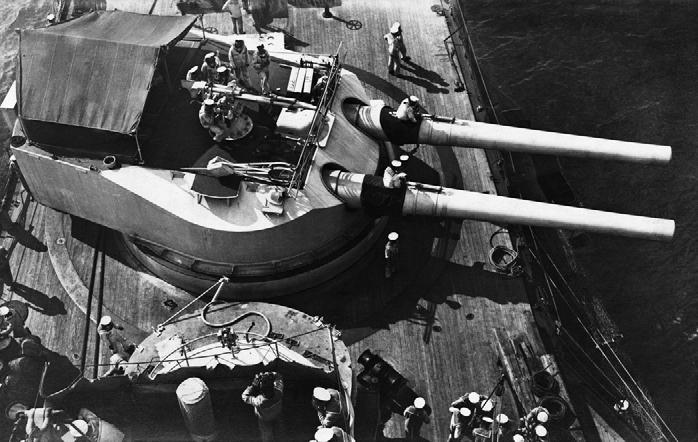
8 minute read
Th e Final Design
clad with charges of 10 kg in 1906, but these tests provided no useful results.64 Due to this fact Popper made his own protective system based purely on theoretical calculations. Th e torpedo bulkhead (gepanzerte Minenboden, armored mine-bottom by the own words of Popper) of the 14,500 ton battleships was 54 mm thick, but the distance between them and the ship’s side shell plating was only 2-1.5 m which was insuffi cient as German test results and war experiences later demonstrated. Th e attempt of the Navy to save money on the tests later caused great losses.
With the change of the caliber of the secondary battery from 19 to 24 cm these ships became mixed large caliber battleships. Despite being obsolete already on the drawing board, they were the fi rst true battleships of the Austro-Hungarian Navy and they were rated powerful ships in the Adriatic and even in the Mediterranean. Th e French were building similar battleships (Danton class armed with 4×30.5 cm and 12×24 cm guns) and the Italians, fi rst time in the history of the rivalry of the two navies had nothing to compare. In Italy there was a gap in the battleship construction between 1903 and 1909 and the battleships of the Regina Elena class were much inferior to the new Austro-Hungarian battleships. Th e fear of these battleships was the main reason for the acceleration of the Italian dreadnought program in 1908. Th e fi rst Italian dreadnought (Dante Alighieri) was laid down in June 1909.
Advertisement
Th e Final Design
Th e fi rst mixed large caliber battleships of the world were the British King Edward VII class battleships and their Japanese copies the Katori class battleships, armed with four 30.5 cm and four 23.4 cm guns. After them four “second generation” mixed large caliber battleship classes were built: the British Lord Nelson, the Japanese Satsuma, the French Danton and the Austro-Hungarian Radetz ky, armed with four 30.5 cm and eight to twelve 23.4-25.4 cm guns. Due to the appearance of the all-big gun battleships all these classes were obsolete even when they entered into service.
Despite its obsolescence, the Radetzky class was a giant leap for the Austro-Hungarian Navy especially in fi repower. Th e displacement of the Radetz ky class battleships was 3,900 tons or 37 percent greater than the displacement of the Erzherzog Karl class battleships. Th e greater part of the increase of the displacement was dedicated to the armament, the thickness of the belt armor was increased only 10 percent (from 210 mm to 230 mm) while the speed of the two classes was identical. Th e weight of the armament of a Radetzky class battleship was 2011 tons while that of an Erzherzog Karl class battleship was 1085 tons.65
Th e Austro-Hungarian Navy introduced the quick-fi ring 30.5 cm guns on these battleships. It’s worth noting that these were the world’s fi rst 30.5 cm guns with wedge breech and metal cartridge case in service on a battleship.66 Th e 30.5 cm/45 Škoda gun had an armor penetration capability almost double that of the old 24 cm/40 gun especially on greater ranges. Th e Austro-Hungarian gun was more potent than the 30.5 cm/40 gun of the Italian standard battleships, its projectile (450 kg) was 70 kg heavier and its armor penetration capability was 50 mm greater on every range.67 Th e new 24 cm/45 guns of the Radetzky class were also better and more potent than the older 40 caliber length guns. Th e fi repower of the Radetzky class radically exceeded the fi repower of the preceding classes. Th e four 30.5 cm guns were mounted on two twin turrets fore and aft and the eight 24 cm guns were mounted on four twin wing turrets, the six turrets were arranged in a hexagonal form. A complicated electromechanical safety system was applied to prevent hitting the other turret. Th is system later proved to be unreliable. Th e weight of a 30.5 cm twin turret was 439 tons, while a 24 cm twin turret weighed 238.8 tons. Th e 30.5 cm and 24 cm gun turrets were all electric operated.
Th e anti-torpedo boat battery consisted of twenty 10 cm/50 guns. Sixteen of them were in casemates on the Batteriedeck and four in the superstructure around the funnels. Th e same guns constituted the main armament of the cruiser Admiral Spaun, the cruisers of the Helgoland class and the destroyers of the Tátra class. Th e ships had three 45 cm submerged torpedo tubes, two broadsides and one on the stem. Th e ships could carry twenty naval mines in a special magazine.
Th e fi re control system of the Radetzky class battleships was quite simple and similar to the prewar system of the Tegetthoff class dreadnoughts. Each of the Radetzky class battleships had two
— 38 —
17 Forward port 24 cm/45 turret on Radetzky
main fi re control stations, one in the fore and one in the aft conning tower. Th e ships had two “wing” control stations for the secondary battery integrated into the superstructure. All these four control stations had their own 9 feet (2743 mm) Barr & Strouds rangefi nders. Th e battleships had two fully equipped fi re control positions which were located fore and aft under the armored deck. Th ese were intended to use only in case of serious damage of the upper positions. Th e Radetzkys also had a fi re control position on the foretop. Th e electric (DC) communication apparatuses were made by Siemens & Halske. Th e battleships had originally six 90 cm searchlights, from 1915 they were fi tted with eight 110 cm and two 90 cm searchlights.
Th e weight of the vertical armor was 3700 tons.68 Th e main belt was 230 mm thick which was even then inadequate when the ships were commissioned. Th e upper belt (Zitadell) was 150 mm thick. Th e main armored bulkheads were also 150 mm thick. Forward and aft of the barbettes of the 30.5 cm turrets the belt armor was reduced in thickness to 100 mm. Th e casemate armor was 120 mm thick. Th e sloped parts of the armored deck were 48 mm thick while the amidships part was 36 mm thick. Over the magazines of the 30.5 cm turrets the Batteriedeck which was one deck above the armored deck (Mitteldeck) was thickened to 30 mm. Th e face and the sides of the 30.5 cm turrets were 250 mm thick, while their roofs were 60 mm thick. Th e face and sides of the 24 cm turrets were 200 mm thick and their roofs 50 mm thick. Th e barbette armor of the 30.5 cm turrets was 250 mm over the Batteriedeck and 80 mm between the Batteriedeck and the Mitteldeck. Th e barbette armor of the 24 cm turrets was 200 mm over the Batteriedeck. Th e fore conning tower had 250 mm thick sides and 60 mm thick roof, while the aft conning tower had 120 mm thick sides and 40 mm thick roof.
As it was mentioned above, the battleships of the Radetzky class were the fi rst Austro-Hungari-
— 39 —

18 30.5 cm twin turret on a Radetzky class battleship. Note the 7 cm/50 AA gun on the turret roof and the metal plates on the deck around the barbette which protected the teak planking from the ejected cartridges
an battleships built with a torpedo protection system, designed by Popper on the basis of purely theoretical calculations. A 54 mm (27+27 mm) thick torpedo bulkhead ran from the forward to the aft 30.5 barbette. Th e distance between the side shell plating and the torpedo bulkhead was 1.5-2 m, because the trunks and magazines of the wing turrets enabled no greater distance. Th is torpedo bulkhead was in fact the reinforced inner plating of the double hull. Due to its limited and insuffi cient deepness this system off ered only the illusion of protection against the underwater threats. Th e construction of the watertight bulkheads was weak and the watertight doors cut in them weakened them further. Due to the known weakness of the bulkheads they had to store a great quantity of timber on these ships for supporting the bulkheads in the case of fl ooding.
Th e units of the Radetzky class as with all of the preceding Austro-Hungarian battleships were fl ushdeckers. Th ey were beamier than the Erzherzog Karl class battleships their beam/length ratio was 5.64 while the Erzherzog Karl’s was 5.78. Th e lack of the raised forecastle deck and the relative low freeboard made them wet ships and their seakeeping abilities were also not the best. Th e relatively large number of crews compared to the ship’s size and the lack of the raised forecastle made the crew compartments very cramped, which was a common problem on every Austro-Hungarian battleship. Th e ships had two pole masts and there was an auxiliary fi re control position on the foretop.
Th e battleships of the Radetzky class were the last Austro-Hungarian battleships built with reciprocating steam engines and the fi rst ones with auxiliary oil fi ring. Th e weight of the machinery complex was 1300 tons.69 Th e machinery consisted of two four-cylinder vertical triple expansion reciprocating steam engines and twelve coal fi ring Yarrow water tube boilers with oil spraying. Each steam engine drove a three bladed manganese bronze screw of 5220 mm diameter. Each steam engine had its own machinery room the two rooms were separated by a longitudinal watertight bulkhead. Th e design power output of the machinery was 20,000 SHP and the design speed of the ships was 20 knots. Th e twelve boilers were arranged in two boiler rooms, six boilers in two rows in each.









